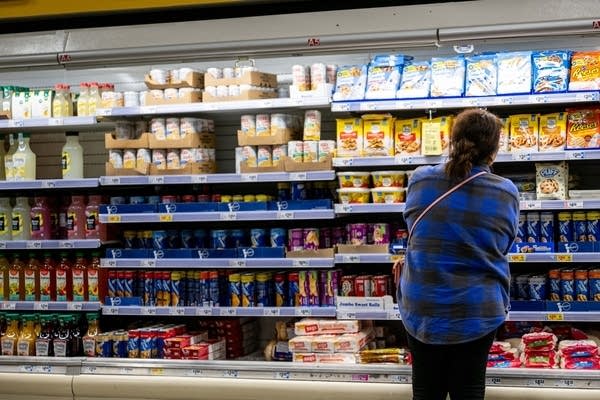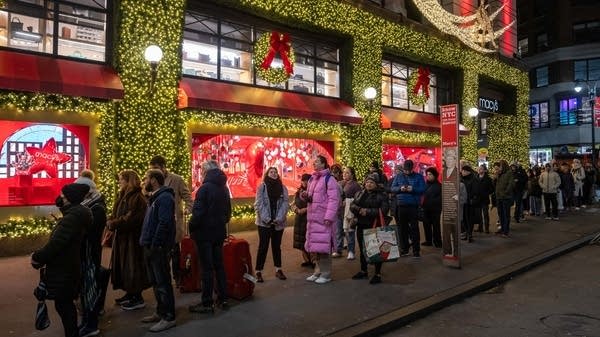Ever wonder who makes those big highway signs?
The people who do may never get a chance to actually see them in use.
American drivers pass any number of road signs on their way home, pointing them in the right direction and warning them when to beware. Few give much thought to where the signs come from, but Marketplace listeners Krisha Chiu of Snoqualmie, Washington, and Kellen McGuire of Los Angeles did. They asked Marketplace to find out.
The answer varies a bit from state to state, but in many cases, all roads lead to prison. Many of America’s highway signs are made by inmates.
One of the largest sign manufacturing plants is at Franklin Correctional Center, a medium-security prison east of Raleigh, North Carolina. Accessing it requires clearing several layers of fences topped with coiled razor wire, surrendering mobile phones, keys and more, all within sight of numerous no-nonsense guards on patrol and posted in a watchtower.
Inside, the space is a hub of different activities. In one area, an inmate feeds a square piece of metal through a heavy-duty machine, chopping each corner to form the familiar octagonal shape of a stop sign. The first thing many visitors notice is just how big the signs actually are. They don’t look quite so huge from a driver’s seat.
The Interstate signs are simply gigantic, like movie screens. On a recent visit, a crane hoisted an exit sign high in the air for inspection. A worker shines a spotlight and peers carefully, checking for errors, damage or defects. Reflectivity is crucial, so motorists can read the sign in all weather conditions, day or night. The sign passes, meaning it will be shipped out and soon directing drivers seeking I-40 East to Greensboro.
Putting the finishing touches on a sign at the Franklin Correctional Center.
Mark Garrison/Marketplace
Another striking thing about the plant is what prisoners work with, including sharp utility knives and power tools. Those are tools, but could also be deadly weapons. And some of the inmates are convicted murderers. But there’s little tension on the plant floor, even as inmates work under the supervision of state employees in close quarters. Many inmates have violent pasts, but the men here have had enough of a track record of good behavior to have moved from maximum to medium security. And they also need a perfectly clean record for at least six months. The jobs are in demand, so standards are high.
“They want a job, and they’ve been infraction free in order to achieve the job,” said Phil Rowe, a civilian who oversees this plant and other facilities for Correction Enterprises, North Carolina’s prison labor agency.
With more than $95 million in annual sales and thousands of inmates at work, it’s one of the largest state prison-labor operations in America. Its leaders are quick to point out that it operates without taxpayer money, funding its budget by selling its products.
Like that train whistle Johnny Cash sang about, the road signs remind inmates of the world beyond the walls. When they imagine what it would be like to actually see their creations out there, they often talk about wanting to take their grandkids to see signs they made.
“It makes me proud,” inmate Odell Blue said. “Making these signs lets other people know which way to go so they won’t get lost.”
There’s pride in creating these signs, but little money. Twenty-six cents an hour is top pay.
Research shows vocational training like prisoners get here makes them more likely to find work and less likely to fall back into crime. But prison labor remains controversial for paying low wages and potentially crowding out private companies that have to offer free-market salaries.
On a break from his work and away from the noise of the plant, inmate Stephon Goode talked about what kind of job he might get on the outside with his new skills, and what it would be like to drive by a sign he made.
“You see something that you had a part in, and it’ll give you a good feeling,” Goode imagined. “Until I actually do it, I can’t really say how it’ll make me feel. But I know it’ll be a good feeling, though.”
He was once on death row for first-degree murder. A judge saved his life, ruling Goode had ineffective counsel. But he still faces life in prison.
“You stay in the courts, and you fight and try to just do your best to make this time go by,” Goode said. “I don’t see myself doing all that time, but hopefully we can see me in the next five years, looking at the signs.”
Next time you drive by one of those signs, think about who made it. They may not see it for a long time.













